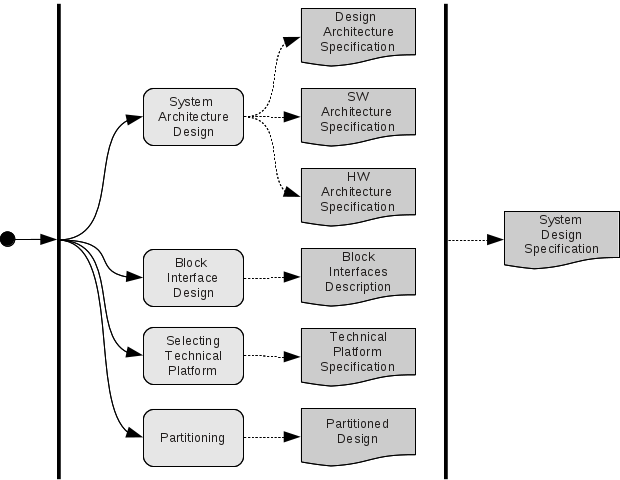Difference between revisions of "General Architecture Design"
(New page: Image:ArchitectureDesignOverview_img.gif Design Criteria Subsystem Design Sequence Diagrams) |
(→How) |
||
| (9 intermediate revisions by 2 users not shown) | |||
| Line 1: | Line 1: | ||
| − | + | <imagemap>Image:GeneralArchitectureDesign.png| | |
| + | rect 148 89 237 144 [[System_Architecture_Design|System Architecture Design]] | ||
| + | rect 151 248 233 304 [[Block_Interface_Design|Block Interface Design]] | ||
| + | rect 153 327 233 384 [[Selecting_Technical_Platform|Selecting Technical Platform]] | ||
| + | rect 155 409 233 465 [[Design_Partitioning|Design Partitioning]] | ||
| + | #<!-- Created by Online Image Map Editor (http://www.maschek.hu/imagemap/index) --> | ||
| + | desc none | ||
| + | </imagemap> | ||
| − | + | ==What== | |
| − | + | A system design | |
| − | [[ | + | ==How== |
| + | |||
| + | '''The Dish''' | ||
| + | |||
| + | A system design with specification of the technical platform, a software architecture and hardware block diagram. | ||
| + | |||
| + | '''Ingredients''' | ||
| + | |||
| + | * Specification from [[General Analysis]] | ||
| + | |||
| + | '''Process''' | ||
| + | |||
| + | Using the previous specifications it is time to partition. The process of partitioning is a process of determining the best, most economical division between hardware and software within the given constraints. | ||
| + | |||
| + | Therefore the activities in this phase is highly parallel and iterative. The developer has to repeat the same process over and over until a satisfying design has been established. | ||
| + | |||
| + | ==Why== | ||
| + | |||
| + | Having analysed the Problem Domain, built a general architecture, fixed the requirements in a formal way and specified the interfaces, a static block architecture has been established without considering how it shall be developed. | ||
| + | |||
| + | Likewise the behaviour of of the system has been established through analysis of the Usage Domain and the interfaces ended in a specification in Activity Diagrams showing the dynamics of the system. | ||
| + | |||
| + | Now it is time to consider how these specifications can be designed into a robust construction obeying the found constraints. This is the time where the developer starts to think ''How can this be designed and implemented''. | ||
| + | |||
| + | The design specifications are the base for the Quotation process, where the developer sets up a development plan and calculates the expected costs. | ||
| + | |||
| + | The design specifications are also the base for the development - the Realisation - of the product when the customer has accepted the quote. | ||
Latest revision as of 08:40, 26 September 2016

What
A system design
How
The Dish
A system design with specification of the technical platform, a software architecture and hardware block diagram.
Ingredients
- Specification from General Analysis
Process
Using the previous specifications it is time to partition. The process of partitioning is a process of determining the best, most economical division between hardware and software within the given constraints.
Therefore the activities in this phase is highly parallel and iterative. The developer has to repeat the same process over and over until a satisfying design has been established.
Why
Having analysed the Problem Domain, built a general architecture, fixed the requirements in a formal way and specified the interfaces, a static block architecture has been established without considering how it shall be developed.
Likewise the behaviour of of the system has been established through analysis of the Usage Domain and the interfaces ended in a specification in Activity Diagrams showing the dynamics of the system.
Now it is time to consider how these specifications can be designed into a robust construction obeying the found constraints. This is the time where the developer starts to think How can this be designed and implemented.
The design specifications are the base for the Quotation process, where the developer sets up a development plan and calculates the expected costs.
The design specifications are also the base for the development - the Realisation - of the product when the customer has accepted the quote.